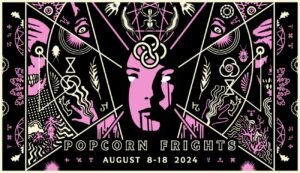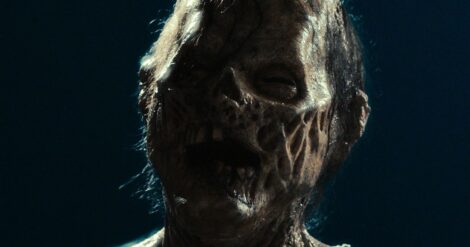
THERE’S A ZOMBIE OUTSIDE, directed by Michael Varrati, is a fresh, queer twist on the zombie genre that staggers between both horror and real life. The film follows a gay filmmaker (Ben Baur) whose creations start creeping into his everyday life, which makes him question what’s real and what’s just in his head. As our protagonist battles his own demons and the monster from his movie, the story highlights the unique struggles of queer creators trying to make their mark. Premiering at Popcorn Frights, this film proudly waves the flag for queer horror and champions the importance of letting queer voices tell their own stories.
The film starts with a group of gay friends gathering to celebrate Adam’s (Baur) birthday. After a boozy brunch of mimosas, the four friends regroup for a bit of a nap and to hurl underhanded insults at each other. This peaceful getaway is supposed to be a pleasant birthday get together not dependent on substance abuse and orgies, but then Adam sees…a zombie outside! Adam, who is known for watching scary movies, gets dismissed as simply imagining the zombie, so his friends and boyfriend continue to mock and ignore his delusion.
With birthdays, people tend to reflect on their past year and judge themselves on where they think they should be and what they should have accomplished by now. Adam’s dream is to create, and he works in theatre and film, but fails to find audiences and garner the appreciation he thinks he deserves. Therefore, this particular birthday celebration turns into a pity party as Adam’s dour manner brings down the mood for everyone—the only thing Adam seems to believe in anymore is that damn zombie.
ZOMBIE starts with a short film (introducing us to Adam) a filmmaker struggling with his own sanity as his creations begin to bleed into his reality. However, as the story unfolds, the film takes a meta turn (revealing that Adam was just a character in the short) and the actor playing him is actually named Ben (just like in real life). The narrative then shifts to Ben’s real life, where he grapples with the fallout of making the short film and his struggles to find success in his career. As Ben’s reality and fantasies start to overlap, the lines between what he created and what he’s experiencing blur, which leaves both him and the audience trapped in a loop where it’s impossible to escape the short.
The film delves into two intertwining themes: the tortured artist’s struggle to create and share his vision, and the deep-seated desire to make art that authentically represents one’s identity (particularly within the queer community). The film reflects the inner turmoil of Adam, who desperately wants to create art that speaks to who he is: a queer filmmaker with a unique voice. However, the industry repeatedly tells him that his identity is “too narrow,” and forces him to conform to roles that don’t reflect his true self. As an actor, Adam is trapped by the expectations of others, with his paychecks dictating his identity rather than his own sense of self. This struggle resonates beyond the character and highlights the broader issue faced by many underrepresented voices in the creative world.
The importance of portraying one’s own voice, especially when it is underrepresented, cannot be overstated. When marginalized voices are silenced or forced to conform, the result is a cultural landscape that lacks diversity and fails to fully capture the spectrum of the human experience. Adam’s journey in the film symbolizes the broader fight for creative autonomy, where the need to make queer art isn’t just about representation: it’s about survival. By pushing against the limitations imposed on him, Adam’s story underscores the essential truth that art is most powerful when it comes from a place of authenticity. The film becomes a poignant commentary on the necessity for queer creators (and all underrepresented voices) to tell their own stories, ensuring that their experiences, perspectives, and identities are not only seen but valued.
In the end, THERE’S A ZOMBIE OUTSIDE’s meta-narrative, where Adam the character becomes Ben the actor, echoes the unsettling themes of NEW NIGHTMARE as Ben is haunted by the very art he created. His conversations with the director (who intriguingly doubles as both the director of the short and the feature) highlight the struggle to escape not just the zombie, but the oppressive constraints of an industry that tries to define him. This singular zombie’s relentless pursuit (even beyond the confines of the short) makes this film a unique entry in the genre. THERE’S A ZOMBIE OUTSIDE isn’t just a horror movie, but a commentary on the creative process, identity, and the inescapable nature of the stories we tell.
Tags: Ben Baur, Film Festivals, LGBTQIA+ horror, Michael Varrati, Popcorn Frights, Popcorn Frights 2024, Queer Horror, There's A Zombie Outside, Zombies



No Comments